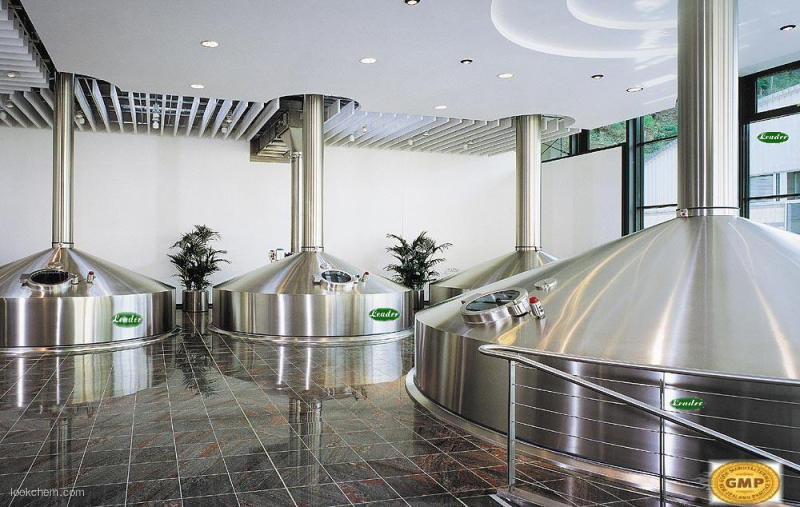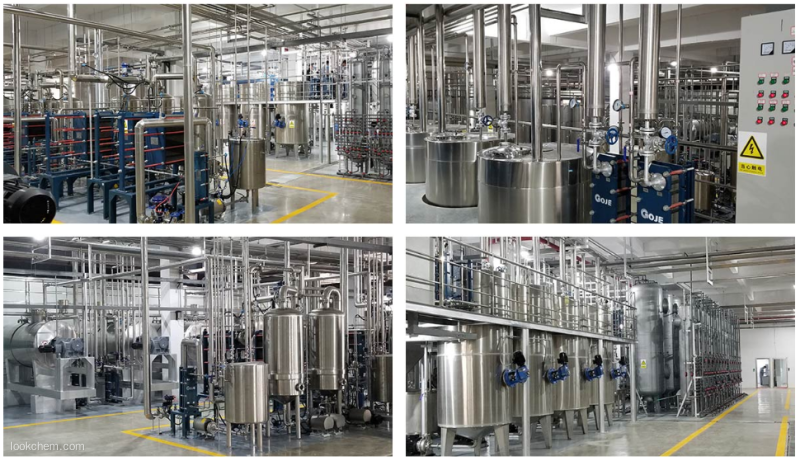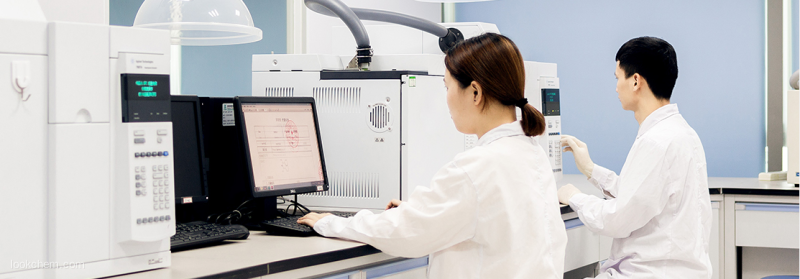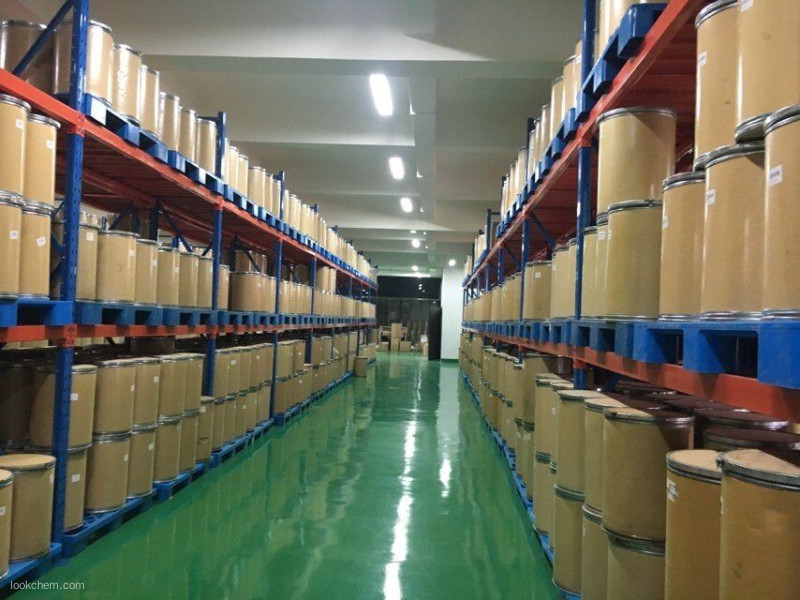PRODUCT DETAILS
| |
| Sodium erythorbate Chemical Properties |
| Provider |
Language |
| D-Sodium isoascorbiate |
English |
| |
| Sodium erythorbate Usage And Synthesis |
| Identification test |
Solubility: it is easily soluble in water; extremely difficult to dissolve in ethanol. It can be measured according to the OT-42 method.
Take 2 ml of 2.0% sample solution; add 2 mL of water, 0.1 g sodium bicarbonate and 0.02 g of ferrous sulfate. Stand after shaking. At this time, it should exhibit dark purple color while addition of 5 mL of dilute sulfuric acid test solution (TS-241) will make the color disappeared.
The burning residue of the sample was dissolved by the water and subject to (TS-2) acidification, and if necessary, subject to filtration. Addition of uranyl zinc acetate test solution (TS-253) should produce yellow crystalline precipitate.
The aqueous solution of the sample allows the discoloration of the 2, 6-dichloroindophenol test solution (TS-84). |
| Content analysis |
0.400 g of the sample pre-dried in a vacuum desiccator (sulfuric acid) for 24 hours was dissolved in a mixed solution consisting of 100 ml of de-carbonated water and 25 ml of dilute sulfuric acid solution (TS-241). Add a few drops of starch solution (TS-235) and immediately titrate with 0.1mol/L iodine solution titration. Each mL of 0.1 mol/L iodine solution was equivalent to 10.807 mg of sodium erythorbate (C6H7O6Na H2O). |
| Toxicity |
ADI is not subject to any special provision (FAO/WHO, 2001).
LD50} 15.3 g/kg (mouse, orally). |
| Usage limit |
GB 2760-2001 (g/kg): beer 0.04; wine, fruit and vegetable juice drinks, 0.15. Canned fruits and vegetables, canned meat, jam, frozen fish, 1.0 (all based on ascorbic acid).
FAO/WHO (1984): luncheon meat, boiled forelegs, cooked ham, cooked minced meat, 500mg/kg (single usage amount or combined amount with ascorbic acid, ascorbic acid and its salts in ascorbic acid). |
| Standard for Allowable Maximum Residue and Maximal amount of Food Additives |
Name of additive
Food allowed to use it as additives
Function of additives
Maximal allowable usage (g/kg)
Sodium Isoascorbate
Eight-treasure porridge
Anti-oxidants
1.0
Sodium Isoascorbate
Soy sauce, vinegar, sauce, liquid compound seasoning
Anti-oxidants
1.0
Sodium Isoascorbate
Tea and coffee drinks
Anti-oxidants
0.5
|
| Chemical properties |
It appears as white to yellow-white crystalline powder or granules. It is almost odorless, slightly salty. In the dry state, it is quite stable in the air. However in solution, it will deteriorate in the presence of air, trace metals, heat and light. The melting point is above 200 ℃ (decomposition). It is soluble in water (17g/100m1) but almost insoluble in ethanol. The pH of the 2% aqueous solution was 5.5 to 8.0. |
| Uses |
It is antioxidant and antiseptic.
Sodium Isoascorbate is a water-soluble antioxidant which is widely used in China and abroad. Its antioxidant property is significantly stronger than vitamin C. Its price is cheap as well. China provides that it can be used for all types of canned, jam and frozen fish with the maximum usage amount of 1.0g/kg; It can be used for meat with the maximum usage amount being 0.5g/kg (to ascorbic acid dollars); can be used for wine and fruit juice drinks with the largest usage amount being 0.15g/kg; can also be used for beer with the maximum usage amount being 0.04g/kg.
For food antioxidants, preservatives and coloring agent |
| Preparation |
It is produced through using D-glucose fermentation of Pseudomonas fluorescens Kl005 or Arthrobacter globiformis K1022 to produce 2-keto-D-gluconic acid (or calcium salt), followed by being esterified, transformed and refined. The composition of the fermentation medium is: glucose: 18; yeast extract 0.3; K2HPO4 • 3H2O: 0.05; KH2PO4: 0.05; MgSO4 • 7H2O: 0.025,;CaCO:34.5. The fermentation temperature is controlled at 30~35 ℃, the fermentation period is 30h, and the fermentation conversion ratio (%) is 79.9%. The fermentation broth is supplemented with sulfate and activated carbon for acidification and decoloring, followed by pressurized filtrate to obtain the clean liquid with a yield of 96.6%.
The purified fermentation broth was concentrated by decompression, and methanol and sulfuric acid were added for refluxed esterification of 5h, followed by frozen and centrifuged filtering to obtain methyl ester with a yield of 82.1%. The methyl ester was transformed with basic methanol solution under refluxing conditions, and the product was further frozen and crystallized to dryness to obtain the crude product of D-isoascorbic acid. The conversion yield was 87.3%, and it was dissolved in hot water and decolorized with activated carbon. The filtrate is pressurized filtrated and the supernatant liquid is frozen, crystallized, centrifugalized, washed and vacuum dried to obtain finished product.
The mother liquid is recovered and the yield is 88.0%. |
| Chemical Properties |
WHITE CRYSTALLINE POWDER |
| Uses |
Antioxidant and preservative. |
| Uses |
Sodium Erythorbate is an antioxidant that is the sodium salt of erythorbic acid. in the dry crystal state it is nonreactive, but in water solution it readily reacts with atmospheric oxygen and other oxidiz- ing agents, a property that makes it valuable as an antioxidant. during preparation, a minimal amount of air should be incorpo- rated and it should be stored at a cool temperature. it has a solubility of 15 g in 100 ml of water at 25°c. on a comparative basis, 1.09 parts of sodium erythorbate are equivalent to 1 part of sodium ascor- bate; 1.23 parts of sodium erythorbate are equivalent to 1 part ery- thorbic acid. it functions to control oxidative color and flavor deterioration in a variety of foods. in meat curing, it controls and accelerates the nitrite curing reaction and maintains the color brightness. it is used in frankfurters, bologna, and cured meats and is occasionally used in beverages, baked goods, and potato salad. it is also termed sodium isoascorbate. |
| General Description |
Almost odorless fluffy, white to off-white crystalline powder. Used as an antioxidant and preservative. |
| Air & Water Reactions |
Water soluble. |
| Reactivity Profile |
Sodium erythorbate may be sensitive to prolonged exposure to light. Incompatible with strong oxidizing agents . |
| Fire Hazard |
Flash point data for Sodium erythorbate are not available; however, Sodium erythorbate is probably combustible. |
| |
| Sodium erythorbate Preparation Products And Raw materials |
|
|
|
|
|
|
|
Group profiles
Leader Biochemical Group is a large leader incorporated industry manufacturers and suppliers of advanced refined raw materials From the year of 1996 when our factory was put into production to year of 2020, our group has successively invested in more than 52 factories with shares and subordinates.We focus on manufacture Pharm & chemicals, functional active ingredients, nutritional Ingredients, health care products, cosmetics, pharmaceutical and refined feed, oil, natural plant ingredients industries to provide top quality of GMP standards products.All the invested factories' product lines cover API and intermediates, vitamins, amino acids, plant extracts, daily chemical products, cosmetics raw materials, nutrition and health care products, food additives, feed additives, essential oil products, fine chemical products and agricultural chemical raw materials And flavors and fragrances. Especially in the field of vitamins, amino acids, pharmaceutical raw materials and cosmetic raw materials, we have more than 20 years of production and sales experience. All products meet the requirements of high international export standards and have been recognized by customers all over the world. Our manufacture basement & R&D center located in National Aerospace Economic & Technical Development Zone Xi`an Shaanxi China. Now not only relying on self-cultivation and development as well as maintains good cooperative relations with many famous research institutes and universities in China. Now, we have closely cooperation with Shanghai Institute of Organic Chemistry of Chinese Academy of Science, Beijing Institute of Material Medical of Chinese Academy of Medical Science, China Pharmaceutical University, Zhejiang University. Closely cooperation with them not only integrating Science and technology resources, but also increasing the R&D speed and improving our R&D power. Offering Powerful Tech supporting Platform for group development. Keep serve the manufacture and the market as the R&D central task, focus on the technical research. Now there are 3 technology R & D platforms including biological extract, microorganism fermentation and chemical synthesis, and can independently research and develop kinds of difficult APIs and pharmaceutical intermediates. With the strong support of China State Institute of Pharmaceutical Industry (hereinafter short for CSIPI), earlier known as Shanghai Institute of Pharmaceutical Industry (SIPI), we have unique advantages in the R & D and industrialization of high-grade, precision and advanced products. Now our Group technical force is abundant, existing staff more that 1000 people, senior professional and technical staff accounted for more than 50% of the total number of employees, including 15 PhD research and development personnel, 5 master′ S degree in technical and management personnel 9 people. We have advanced equipment like fermentation equipment and technology also extraction, isolation, purification, synthesis with rich production experience and strict quality control system, According to the GMP required, quickly transforming the R&D results to industrial production in time, it is our advantages and our products are exported to North and South America, Europe, Middle East, Africa, and other five continents and scale the forefront in the nation, won good international reputation. We believe only good quality can bring good cooperation, quality is our key spirit during our production, we are warmly welcome clients and partner from all over the world contact us for everlasting cooperation, Leader will be your strong, sincere and reliable partner in China.
Our Factories production lines



Our Factories R&D ability


Our Factories warehouse




 Premiumsupplier
Premiumsupplier 



